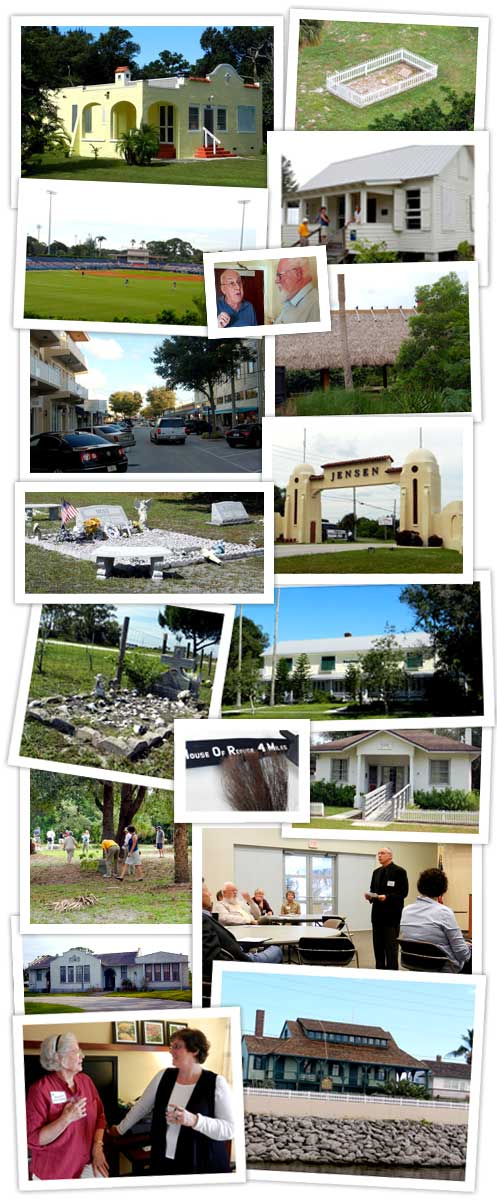Boom and Bust: Landscapes of Economic and Cultural Transition
Click any image for a larger view and/or to view the photos as a slide show. (Use the arrow keys on your keyboard to move through the slideshow, if you wish.)

A Spanish Mission-style house, Fellsmere, Florida (Photo courtesy of Cathy Wilson)
The Children's Cemetery, Jupiter, Florida; the small, fenced cemetery, adjacent to the Jupiter Inlet Lighthouse, contains the graves of the stillborn children of lighthouse keeper Joe Wells (keeper from 1908-1918) and his wife, Katherine Armour Wells. (Photo courtesy of Scott Roper)
Historic Holman Stadium in Dodgertown, Vero Beach, Florida, was designed by New York architect Norman Bel Geddes and engineer Emil Praeger. It was built in 90 days in 1953 at a cost of $100,000.00. The stadium was considered innovative for its open-air dugouts, a roofless grandstand that put fans close to the playing field, and the excavation of the playing surface and the re-use of soils both to support the structure of the grandstand and to form the outer edge of the outfield. (Photo courtesy of Cathy Wilson)
The George Washington Tindall Pioneer Homestead, Jupiter, Florida; the home is an 18-foot by 30-foot frame house, made of southern pine and cypress wood, with an attached kitchen and breezeway. It was built in 1892 by Georgia native, George Tindall, and is not only one of the oldest homes in Palm Beach County, Florida, but it is considered to be one of the best surviving examples of South Florida's historic Cracker-style architecture. (Photo courtesy of Scott Roper)
Conference Program Chair, Marshall Bowen of Fredericksburg, VA, and Allen Noble of Akron, OH, trade stories of harrowing fieldwork experiences. (Photo courtesy of Cathy Wilson)
A Seminole Chickee, Jupiter, Florida; a Chickee is a shelter supported by posts, with a raised floor, a thatched roof and open sides. It is normally built of palmetto thatch over a bald cypress log frame. The Chickee-style of architecture was adopted by the Seminole Indians during the Second and Third Seminole Wars as the United States military forced them to retreat into the Everglades and surrounding areas. (Photo courtesy of Scott Roper)
Busy Flagler Avenue in the downtown historical district of Stuart, Florida. (Photo courtesy of Scott Roper)
The Jensen Beach side of the historic Stuart Welcoming Arch on State Route 707 in Jensen Beach, Florida. The arch was built in 1926 to mark what was then the town line between the town of Jensen Beach to the north and the town of Stuart to the south. The Stuart Welcoming Arch was the recipient of a 2011 PAS: APAL Historic Preservation Certificate of Merit. (Photo courtesy of Cathy Wilson)
A modern gravesite in the newer section of Brookside Historical Cemetery outside of Fellsmere, Florida. The grave is oriented to the East, outlined with paving bricks, covered with a blanket of gravel, decorated with grave goods, and includes a memorial bench for visitors. (Photo courtesy of Cathy Wilson)
A modern gravesite in the newer section of Brookside Historical Cemetery outside of Fellsmere, Florida. The grave is oriented to the East, outlined with paving bricks, shows signed of having been scrapped and covered with seashells, and is sparsely decorated with grave goods. Its cross-shaped headstone features several ceramic memorial pictures. (Photo courtesy of Cathy Wilson)
The Fellsmere Inn, the oldest building in the town's business district on Broadway Street, was constructed about 1910 by the Fellsmere Farms Company. (Photo courtesy of Cathy Wilson)
PAS: APAL members explore the African-American section of Brookside Historic Cemetery outside of Fellsmere, Florida. (Photo courtesy of Cathy Wilson)
The Marian Fell Library, the oldest library in Indian River County, Florida, was a wood-frame vernacular structure built in 1915 by the daughter of Norman Fell, the founder of Fellsmere, Florida. Although Marian Fell was never a resident of Fellsmere, she wanted to promote literacy and consequently donated money that she made from her translations of Russian literature to build the community's library. (Photo courtesy of Scott Roper)
House of Refuge Mile Markers; these wooden markers were placed at intervals along the Florida coastline to alert shipwrecked survivors who made it ashore as to where they could obtain help and find refuge. (Photo courtesy of Cathy Wilson)
The Pleasant Ridge School (a.k.a. Quay School) was a Spanish Mission-style structure built in 1919 in Winter Beach, Florida (a.k.a Woodley, FL; a.k.a. Quay, FL). It was designed by Vero Beach, Florida contractor, J. Hudson Baker and constructed for $5,000.00. The original building included two classrooms and an auditorium. The school was expanded in 1927 and continued to be used until it was heavily damaged by hurricanes in 2004. (Photo courtesy of Scott Roper)
Executive Director Wayne Brew of Philadelphia, PA, welcomes conference participants to the Friday Paper Sessions at the Wolf High-Technology Center at Indiana River State College in Stuart, Florida. (Photo courtesy of Cathy Wilson)
Margaret Rasmussen of Gainesville, Georgia and Tracey Sculle of Sherman, Illinois catch up during an informal, late afternoon get-together. (Photo courtesy of Cathy Wilson)
Gilbert's Bar House of Refuge on Hutchinson Island, Stuart, Florida, is the only remaining House of Refuge along Florida's east coast. It was built in 1875 as one of ten Houses of Refuge which served as havens for shipwrecked sailors and travelers along the sparsely populated Atlantic coastline of Florida during a time when sailing ships dominated world commerce. (Photo courtesy of Cathy Wilson)
